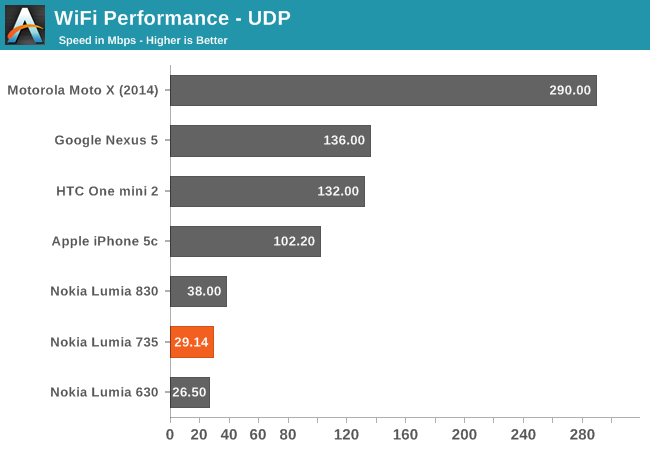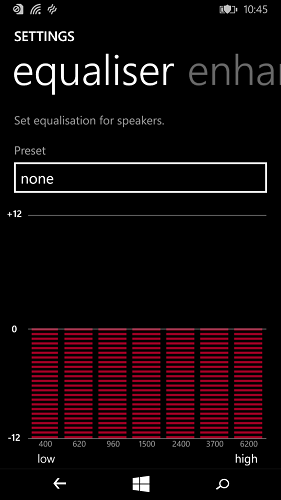Nokia Lumia 735 Review
by Brett Howse on February 3, 2015 6:00 AM EST- Posted in
- Smartphones
- Microsoft
- Nokia
- Lumia
Wi-Fi
Windows Phone does not give us as much access to the hardware as Android, making outright declarations about hardware difficult. However, it is most likely the Wi-Fi solution in the Lumia 735 is the Qualcomm VIVE which is part of the SoC. Unlike the Lumia 830 though, this is a single band only, with one spatial stream. The maximum connection speed is 72.2 Mbps.

Maximum transfer speed that I achieved was only 29 Mbps, which is not fantastic. Many people have faster internet connections in their home, so the 735 will likely not be able to max those out.
Cellular
The MSM8926 SoC supports up to Category 4 LTE, which offers a maximum of 150 Mbps download and 50 Mbps upload, depending on tower traffic, provider hardware, and location of course.
The model shipped for review can support GSM at 850 MHz, 900 MHz, 1800 MHz, and 1900 MHz, along with WCDMA Band 1 (2100 MHz), Band 5 (850 MHz), and Band 8 (900 MHz). LTE FDD is on bands 3 (1800 MHz), 7 (2600 MHz), and 20 (800 MHz). In North America, the main LTE band is band 4, which is not available on this sample to allow LTE speed testing.
GNSS
Qualcomm’s IZat Gen8A is the GPS in the Snapdragon 400 SoC, and as with most modern Qualcomm location solutions it is fast and accurate. With location services enabled on the phone, GPS lock happened within a couple of seconds. Going from location services disabled to a GPS lock took around thirty seconds, which is pretty good.
The Lumia 735 supports A-GLONASS, A-GPS, BeiDou, and assist from cellular and Wi-Fi networks to get a quicker location fix.
Speaker
The Lumia 735 has a single speaker on the back of the device, which reduces bezel sizes but does not give you the optimum location for a speaker. The maximum SPL playing music is around 81 dBA, and the sound quality is as expected not fantastic, with very little low range and a very tinny sound.
If you are to play music on this device, it would be best to do it through either headphones or a Bluetooth speaker. It does have a graphic equalizer, which can be used for the internal speaker or headphones.
Due to technical issues, I am unable to do a recording for call quality at this time.













64 Comments
View All Comments
gijames1225 - Tuesday, February 3, 2015 - link
What's the rationale for when to include and when not to include iPhones in the comparisons? No iPhone was compared in the battery life charts, but it's there in a lot of the other charts.melgross - Tuesday, February 3, 2015 - link
Particularly as it was said that the testing app is now compatable across systems.Brett Howse - Tuesday, February 3, 2015 - link
We pull our data from our online database, and the iPhone would not be included if that particular test was not run on it. GFXBench just updated to this version recently on iOS (by recently I mean since our initial review)gijames1225 - Tuesday, February 3, 2015 - link
Cool, thanks for the explanation.hlovatt - Tuesday, February 3, 2015 - link
There was some comparison against iPhone5c, but inconsistent and missing for performance. So the review was a bit disappointing overall :(Brett Howse - Tuesday, February 3, 2015 - link
Our benchmarks evolve over time, and as new versions come out, we migrate towards them. The 5c was reviewed a while ago, so it would not have been run on benchmarks that came out after its launch, but price wise is still similar to the 735 so I included it where I could. If you want to compare the 735 to any other iPhones, I mentioned in the article that we have a great online tool for that called Bench which you can find a link to at the top of our main page.hlovatt - Tuesday, February 3, 2015 - link
Thanks for your reply. Pity that the newer benchmarks are not available for 5C. I guess that provided that the benchmarks don't continually change this won't be a common problem. Pity in this case, but thanks again for the reply.bullzz - Tuesday, February 3, 2015 - link
@Brett - Great review. in some CPU and GPU benchmarks why does 735 perform 10-30% slower than Moto G. I thought they were using the same socI don't know why anyone would buy this or 830 over Moto G LTE. better performance, better display, better OS. Only upside is battery life but I think MotoG has much better value to it
Daniel Egger - Tuesday, February 3, 2015 - link
Because people typically buy phones for the full package rather than just plain hardware specs? Otherwise neither Motorola nor Microsoft nor Apple would sell any phones...Brett Howse - Tuesday, February 3, 2015 - link
Yes, they are the same SoC. Snapdragon 400 in both. In the web browser tests, Internet Explorer is much slower than Chrome. IE is being replaced though, and the new replacement is already much faster, so on Windows 10, this should be less of an issue.As for the GPU benchmarks, my suspicion is that the video drivers for Adreno are more tuned for Android than they are for Windows Phone with DirectX.